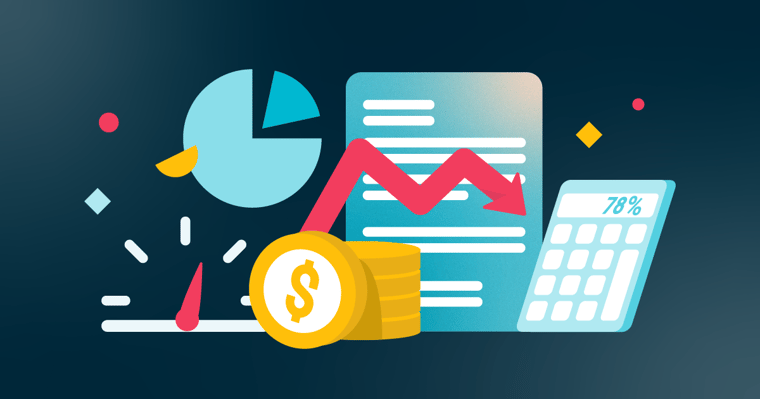The Hidden Costs of Manual Proposal Processes
July 28, 2024Last updated on October 1, 2024

Relying on a manual proposal process may seem cost-effective at first glance, but it can lead to significant hidden costs. From hours spent on repetitive tasks to the increased likelihood of errors to missed opportunities, the true expense of a manual process often remains unseen until it's too late.
The financial implications don’t stop at lost time and opportunities. Errors and inconsistencies in proposals can lead to misunderstandings, contractual issues and ultimately, dissatisfied prospects.
These mistakes can be costly to correct, both in terms of time and money, and can damage your reputation in the long run.
By understanding these hidden costs, you can make more informed decisions that enhance efficiency, improve accuracy and drive better business outcomes.
Lost Time
Imagine your top salespeople spending countless hours drafting, editing and reviewing proposals. Each proposal needs meticulous attention to detail to ensure consistency and accuracy, which can be extremely time-consuming when done manually.
This delays proposal delivery and diverts valuable time away from high-impact activities such as prospect engagement and strategic planning. The opportunity cost is enormous, leading to decreased productivity and missed sales.
Speed Up the Process
When you automate your proposal creation process, your reps regain all that lost time and can focus on more productive activities like qualifying new leads and closing deals.
Proposal automation tools like Proposify can quickly generate proposals from customizable templates, drastically cutting down on preparation time. By automating repetitive tasks like data entry and formatting, your team can focus on creating compelling content and engaging with prospects.
This streamlined proposal process speeds up creation and delivery, and allows your team to work more efficiently.
Errors
Typos, miscalculations and inconsistent information are just a few of the mistakes that can slip through the cracks when proposals are handled manually. These proposal errors can compromise the professionalism of your proposals and can lead to misunderstandings and contractual issues.
Proposal errors can also have far-reaching consequences for your business. Consider the effect of just one numerical error in a pricing section. It could result in significant financial discrepancies that require costly corrections.
Even worse, it might damage your credibility with prospects, making them question your attention to detail and reliability as a vendor.
Increase Accuracy
Proposal automation software like Proposify can significantly reduce the likelihood of errors by standardizing content and ensuring consistency across all documents. Templates can be customized with accurate, up-to-date information for each prospect, minimizing the risk of outdated or incorrect data slipping through.
In addition, integration with CRMs such as HubSpot and Salesforce automatically pull data into the proposal, avoiding human error. This kind of automation ensures accuracy, reducing the need for time-consuming revisions.
By embracing proposal automation, you can enhance the accuracy and professionalism of your proposals and build stronger long-term client relationships.
Slow Turnaround Time
When proposals are crafted by hand, each step—drafting, reviewing, editing and approving—takes considerable time. This lengthy process often results in missed opportunities, as prospective customers may lose interest or choose a competitor who responds more quickly. A slow response can also create a perception of inefficiency and lack of urgency, which can harm your professional reputation.
Manual processes are also prone to bottlenecks. If key team members are unavailable or overwhelmed with other tasks, the entire proposal process can come to a standstill. This delay can frustrate your team and risk losing the deal altogether.
Decrease Turnaround Time
With proposal automation, your team can generate proposals much more quickly. Templates and content libraries streamline the creation process. Automation also facilitates faster approvals and revisions.
With real-time collaboration tools, team members can review and edit proposals simultaneously, reducing bottlenecks and speeding up the entire process.
This efficiency allows you to respond to prospect inquiries promptly, keeping them engaged and increasing your chances of winning the deal.
Inconsistencies
When each proposal is crafted from scratch or copied from previous versions, variations in style, format, and content are inevitable. These inconsistencies can confuse prospects, weaken your brand identity, and create an impression of disorganization and lack of attention to detail, all of which can result in lower close rates.
Imagine a scenario where one proposal uses a different pricing format than another, or where key information is presented in various ways across several documents. Such inconsistencies can lead to misunderstandings and miscommunications with prospective customers, potentially jeopardizing deals.
Maintain Consistency
By using standardized templates and centralized content libraries, automation ensures that your team is maintaining brand consistency with every proposal. This enhances the professionalism of your proposals, and makes them easier for prospects to read and understand.
Automation also allows for easy updates across all proposals. If a pricing structure changes or new information needs to be included, you can update the template once, and all future proposals will reflect these changes. This consistency builds trust with prospects and reinforces your brand’s reliability.
Incorporating proposal automation into your workflow can eliminate inconsistencies, improve the clarity and professionalism of your proposals, and strengthen your overall brand image. It’s a simple step that leads to more compelling proposals and more successful outcomes.
Lack of Scalability
As your business grows and the volume of proposals increases, managing each one manually becomes increasingly cumbersome and time-consuming. This bottleneck can stifle growth as your team struggles to keep up with the demand, often leading to rushed, error-prone work.
When relying on manual methods, scaling up typically means hiring more staff, which increases overhead costs. With a larger team, the risk of inconsistencies and errors increases, and the proposal development process can still be slow and inefficient.
Scale Without Increasing Overhead
By automating repetitive tasks and implementing content standardization, your existing team can handle a much higher volume of proposals without sacrificing quality or speed. Automated systems can quickly generate personalized proposals using templates, ensuring each one is accurate and consistent, regardless of how many are being produced.
Proposal automation software like Proposify allows for easy updates and modifications across all proposals, ensuring that any changes in pricing, branding or content are instantly reflected. This scalability enables your business to grow and adapt without the need for a proportional increase in resources.
Lower Close Rate and Lost Revenue
Errors can lead to misunderstandings and erode trust with prospective customers. A slow turnaround time can cause prospects to lose interest or move on to a competitor who responded more quickly. Inconsistencies in branding, messaging and formatting can create confusion and diminish your professionalism, making your proposals less persuasive.
All these factors and more are inherent to manual proposal creation, and can contribute to a lower close rate, meaning fewer deals are secured, and potential revenue is lost.
Increase Close Rate and Revenue
Proposal automation can significantly improve your close rate by streamlining the entire proposal management process.
Automated systems can also track and analyze proposal performance, providing insights that help refine and improve future proposals, thereby increasing close rates and revenue.
Automate Your Proposal Process with Proposify
If you're ready to get back your team's time and boost revenue, you're ready for Proposify. It has everything your team needs to automate proposal production and avoid losing out on valuable deals. And our proposal software gives you end-to-end control and visibility into your sales process.
Schedule a demo today, and see how you can increase efficiency with integration and automation.

Michelle Lowery is a B2B and B2C writer and editor with more than 15 years of experience. She believes empathy is the key to high-performance content. Connect with her on LinkedIn:



